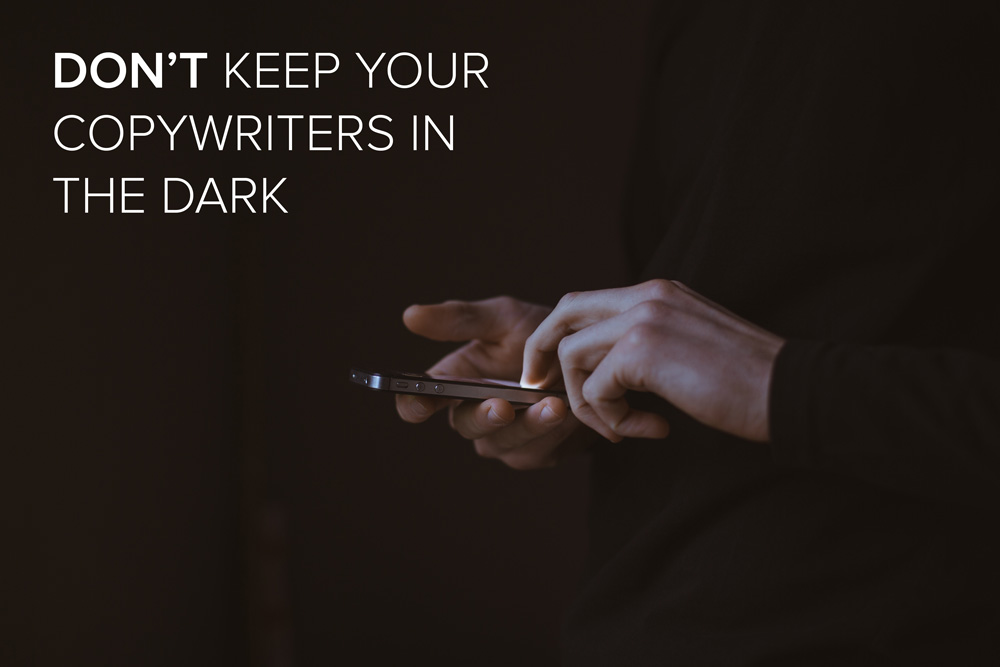I’ve learned to be wary of first projects for a new client. Having to write, say, a ground-breaking ebook for a company you’ve never met is a fraught and unnerving job.
That’s because, in my experience, the copywriter-onboarding process tends to go something like this:
1) The end-client appoints a marketing agency.
2) The client and the agency team spend a long time together in meeting rooms, strategising, planning, workshopping, coming up with radical new perspectives, and generally getting to know each other. It is a joyful time, like the first days of Spring, or the first rush of new love.
3) In this first rush of new love, agency and client weave a wonderful story. They develop a radical new perspective on server virtualization that will change the way the world looks at server virtualization forever. They absolutely must produce an ebook, straightaway, to tell the radical new server virtualization story to a waiting worldwide audience.
The ebook will capture the spirit and essence of the client company. It will be edgy, warm, provocative, bold, human, witty and knowing. It will be downloaded thousands of times by people with money to spend on server virtualization, and convince them to book demos of the client’s software. It will almost certainly be the best ebook about server virtualization ever created.
4) On a caffeine high, the agency promises to deliver the ebook draft by the end of the week. High fives all round. Champagne at the airport bar on the way home.
5) Day dawns. The agency team convenes to discuss the production of the ebook. Does anyone have time to write it? No! Help! Time to call a copywriter!
The phone rings. Can I, the copywriter, write an earth-shattering ebook that will change the way the world views server virtualization forever? And can I do it by the end of the week?
Never wanting to let a client down, I say yes, of course. No problem. (This, incidentally, is one of the many reasons we hired Sophie, Chloe and Sarah – they’re very good at not letting me say that.)
That’s when the problems start.
Here’s the thing: at this point I know nothing about the new client. I wasn’t in the room for the birthing of the radical new perspective. The new client, exhausted from the effort of bringing the radical new perspective into the world, doesn’t especially want to re-live the whole experience again with me, a complete stranger who has contributed nothing to the process so far. (Especially if they thought it was going to be written by the people who actually were in the room at the time.)
All I have in front of me is a one-page brief from the agency, a PowerPoint deck the client presented at a recent conference, and a couple of analyst reports they sent over that “might help”.
In the old days, at this point I would think: “Well, I’ll just write what I think it ought to say, and the client can fill in the gaps when they see the first draft.”
I have discovered the hard way that this is the wrong thing to do.
If you ever find yourself in a similar situation, and you want to avoid endless rewrites, going massively over time, and ending up doing hours of unpaid work, here’s what to do.
1. Push the deadline back.
You are not going to write an entire ebook for a completely new client by the end of the week. At least, not one that’s going to set the world on fire with its compelling and radical new perspective on server virtualization. Negotiate a deadline that gives you time to do the thing properly.
2. Get to talk to the end client.
Even if the client thinks the briefing phase ended with the agency workshops, and that now is the time for action, stand your ground. You need to talk to them – and you need to talk to as many people there as you can in the time that you have.
On those calls you need to very quickly get a feel for where this client is coming from, what’s new and radical about their new perspective, and what the company’s personality is.
(I find it extraordinarily hard to develop a ‘voice’ for a company without talking to lots of people who work there. I have huge admiration for copywriters who can come up with a bold worldview and a distinctive tone of voice seemingly at the drop of a hat.)
3. Better still, be at the initial workshops in the first place.
Every really good piece I’ve ever written was really good because I was at the kick-off, and heard first-hand from the client where they’re coming from, what story they want to tell, who they want to tell it to, and what makes it exciting.
If the client’s genuinely excited, then I’m genuinely excited for them, and that comes out in the writing. When you’re hearing a pitch second-hand, or if the client has gone through it several times already, it can lose a lot of detail and vigour.
3. Develop a persona.
Find out who the ebook needs to appeal to. Who is this person, and what makes them tick? If you can get an idea of target job roles and types of organisation, you can start looking at relevant job ads and profiles on LinkedIn, to get a feel for what the target audience do, what they’re tasked with doing, and – usually by finding them on Twitter – what kind of language they use. Use all that to talk to them in their own words, about things they care about.
4. Produce an outline.
Offer to write an outline before you start on the first draft. This will not only buy some time, but more importantly, will make sure you’re on the right track. The outline will show how you intend to structure the ebook, what points you plan to cover in each section, and give an idea of the tone and voice you’re going to use. Getting the client’s feedback on the outline will help to identify any misunderstandings or wrong directions early, which will make for plainer sailing later.
5. Read everything you can before starting on the copy.
Read all your notes from the briefing calls/meetings you’ve now had, and any other information you can get your hands on, many times before you start writing. Make a list of quotes and stats you’re going to use to support the argument. You need to be absolutely clear in your head what the story is, and how it unfolds, and how you’re going to back it up, before you start. Otherwise you’ll find yourself constantly breaking off from writing to look up supporting facts. Then invariably you’ll find other facts that suggest your argument is wrong, then you’ll try to re-work the entire ebook on the fly, then you’ll run out of time, and the first draft will be a poorly thought-out mish-mash.
6. That’s it!
If you’ve had some good chats with the client, developed a clear idea of who the audience is, produced an outline everyone is happy with, and assembled all the information you need, you’re ready to produce a first draft that is highly likely to be met with approval, and make your agency client look good to the end-client (which is always a plus). Happy writing!
Want copywriting advice sent straight to your inbox?
Sign up for our monthly insights email for B2B copywriting tips to help your content get noticed.


